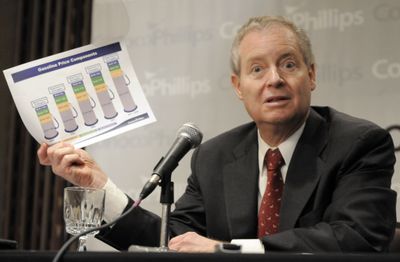Oil giants yet to boost exploration
Most profits go toward stock dividends, buybacks

HOUSTON – As giant oil companies like Exxon Mobil and ConocoPhillips get set to report what will probably be another round of eye-popping quarterly profits, just where is all that money going?
Companies insist they’re trying to find new oil that might help bring down gasoline prices, but the money they spend on exploration is nothing compared with what they spend on stock buybacks and dividends.
The five biggest international oil companies plowed about 55 percent of the cash they made from their businesses into stock buybacks and dividends last year, up from 30 percent in 2000 and 1 percent in 1993, according to Rice University’s James A. Baker III Institute for Public Policy.
The percentage they spend to find deposits of fossil fuels has remained flat for years, in the mid-single digits.
The issue has become more sensitive as lawmakers and Americans frustrated by high gas prices have balked at gaudy reports of oil industry profits. ConocoPhillips is scheduled to kick off the latest round of big oil earnings reports Wednesday.
In the first three months of this year, Exxon Mobil Corp., the world’s biggest publicly traded oil company, shelled out $8.8 billion on stock buybacks alone, compared with $5.5 billion on exploration and other capital projects.
ConocoPhillips has told investors that its stock buybacks for April to June of this year will come to about $2.5 billion – nine times what it spent on exploration.
Stock buybacks are common throughout corporate America. They shrink the amount of stock on the open market, essentially increasing its value and giving individual shareholders a bigger stake in the company.
But some critics say Big Oil focuses too much on boosting stock prices, in an industry that sometimes ties executive pay to stock price.
“If you’re not spending your money finding and developing new oil, then there’s no new oil,” said Amy Myers Jaffe, an energy expert at Rice University who’s studied spending patterns of major oil companies.
Investor-owned companies like Exxon Mobil and Chevron hold less than 10 percent of global oil and gas reserves, way down from past decades. And finding new oil has become harder and more expensive.
State-run oil companies, like those in Saudi Arabia and Venezuela, control about 80 percent of reserves – and at today’s prices, it’s not surprising they’re keeping a tight grip on what they have. Scarce equipment and hard-to-find labor also pose problems.
No one questions that big oil is rolling in cash. The cash the biggest oil companies bring in from running their businesses, or operating cash flow, is four times what it was in the early 1990s.
“It becomes a management decision,” said Howard Silverblatt, a senior index analyst at Standard & Poor’s. “It’s not like they’re going to the board and saying, ‘Well, I can do one or the other or the other.’ The balance sheets are flush with cash.”
Companies say they are doing what they can to find more fossil fuels around the world, but the easy oil is gone. Exploring could mean expensive projects in thousands of feet of water in the Gulf of Mexico or costly ventures pulling petroleum from Canada’s vast oil-sands deposits.
TransCanada Corp. and ConocoPhillips Co. just said they’d spend $7 billion to nearly double the amount of crude flowing through a pipeline from Canada’s tar sands to the U.S. Gulf Coast.
And analysts point out that because there’s no guarantee oil prices will stay in the stratosphere, oil companies should approach exploration projects with caution.
“There’s only so much money you can throw at it without being ridiculous,” said Joseph Stanislaw, a senior adviser to Deloitte LLP’s Energy & Resources practice. “I think they’re doing what they can.”
Exxon Mobil, known for its disciplined approach to investing in energy projects, has drawn criticism for its reluctance to invest in alternative energy sources like wind and solar power.
The company expects to spend $25 billion to $30 billion on capital and exploration projects each of the next five years. Last year, it spent about $32 billion on share buybacks.
Exxon Mobil often touts its $100 million contribution to Stanford University’s Global Climate and Energy Project. By contrast, BP says it plans to spend $8 billion over the next decade developing alternative energy using wind, hydrogen and other means.